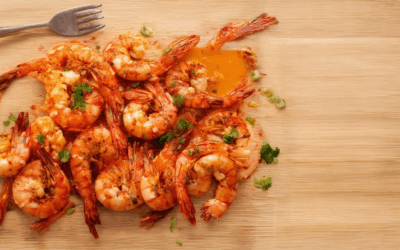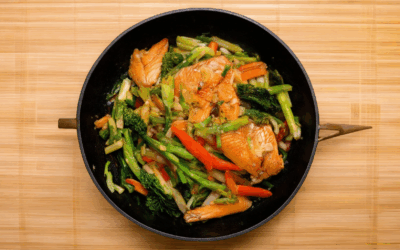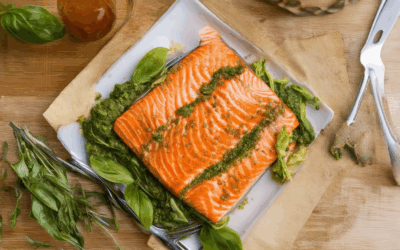Cooking frozen fish is a convenient and delicious way to enjoy fresh-tasting meals anytime, whether you’re short on time or simply prefer the ease of working with pre-frozen ingredients. From pan-searing to oven-baking, air frying, or even grilling, there are countless methods to cook frozen fish, each offering unique advantages and flavors. In this guide, we’ll explore everything you need to know to master the art of cooking frozen fish, including tips, tricks, and answers to common questions like whether it’s safe to cook frozen fish without thawing and how to achieve perfectly cooked fish every time. Whether you’re a seasoned home cook or new to working with frozen seafood, this article will provide you with the insights and techniques needed to elevate your frozen fish cooking game.
Key Takeaways
- Effective Defrosting Techniques: Master refrigerator, cold water, and microwave methods for defrosting frozen fish, ensuring optimal texture and flavor.
- Adjusted Cooking Times: Extend cooking time by 50% when preparing frozen fish to avoid overcooking and ensure thorough thawing during cooking.
- Air Fryer Mastery: Achieve perfect results in an air fryer by preheating and adjusting cooking times, ensuring crispy and flavorful meals.
- Prevent Sogginess: Use cold water, microwave, refrigerator, colander, or air-drying methods to keep frozen fish firm and less soggy.
- Ensure Proper Doneness: Use a food thermometer to reach 145°F (63°C) or check for flakiness to confirm your fish is perfectly cooked.
- Enhance Flavor: Boost taste with seasoning or a saltwater brine before cooking for a more delightful dining experience.

What is the Best Way to Cook Frozen Fish?
To cook frozen fish effectively, follow these simple steps:
- Preheat Oven to 425°F (220°C) – This ensures even cooking and crispy skin if desired.
- Prepare Cooking Surface – Line a baking sheet with parchment paper or use a non-stick surface.
- Season the Fish – Brush with olive oil, then sprinkle with salt, pepper, and your favorite spices.
- Bake for 20-25 Minutes – Check for flaking after 20 minutes; if still firm, extend cooking time by 5 minutes.
- Check Doneness – Insert a fork into the thickest part; if it separates easily, the fish is done.
Alternative Methods:
Pan-Frying
- Heat a skillet over medium heat with oil or butter.
- Add frozen fish fillets and cook for 4-5 minutes per side.
- Flip and continue cooking until golden brown and cooked through.
Grilling
- Preheat grill to 425°F (220°C).
- Place fish on a greased grill rack.
- Cook for 4-5 minutes per side, adjusting heat as needed.
Deep Frying
- Heat oil to 375°F (190°C) in a deep pot or fryer.
- Dip fish in flour or batter and fry for 3-4 minutes per side.
- Remove and drain on paper towels before serving.
Tips for Success:
- Bread the fish for extra crunch.
- Use herbs and spices for added flavor.
- Defrost fish slightly if you prefer a softer texture.
For more detailed guides and recipes, visit Only Fish Recipes .
Is it bad to cook frozen fish without thawing?
No, it is not bad to cook frozen fish without thawing it first. In fact, cooking frozen fish directly from the freezer can be a convenient and effective method, preserving its texture and flavor. Here’s how you can do it:
Methods to Cook Frozen Fish Without Thawing:
- Baking: Preheat your oven to 425°F (220°C). Place the fish on a baking sheet or parchment paper, drizzle with olive oil, and season with your preferred spices. Bake for 15-20 minutes, or until the fish reaches an internal temperature of 145°F (63°C).
- Grilling: Preheat your grill to medium-high heat. Place the frozen fish on a greased grill rack. Grill for about 4-5 minutes per side, or until cooked through. Check with a fork to ensure it’s flaky and cooked evenly.
- Pan-Searing: Heat a skillet or frying pan over medium-high heat. Add a small amount of oil or butter. Once hot, place the frozen fish skin-side down in the pan. Cook for 3-4 minutes, then flip and cook the other side for another 2-3 minutes. Use a spatula to check for doneness.
Tips for Success:
- Season the fish generously before cooking for added flavor.
- Use a meat thermometer to ensure the fish reaches the recommended internal temperature for safety.
- For a crisper texture, consider adding a bit of oil or butter during cooking.
Cooking frozen fish without thawing is a simple and efficient method that works well for busy weeknights or last-minute meals. Enjoy your fresh-tasting seafood dish without the hassle of defrosting!

Is it Safe to Cook Raw Fish from Frozen?
Yes, it is safe to cook raw fish from frozen. Freezing fish at its raw state helps preserve its freshness and prevents it from spoiling. Cooking frozen fish directly is a convenient and safe option, as it maintains the fish’s texture and flavor. Below are some tips for cooking frozen fish effectively:
- Pan-Frying : Heat a skillet or frying pan over medium-high heat. Add oil or butter, then carefully place the frozen fish fillets in the pan. Cook for about 4-5 minutes per side, or until the fish reaches an internal temperature of 145°F (63°C). Avoid overcooking, as this can make the fish dry.
- Grilling : Preheat your grill to medium-high heat. Place the frozen fish on the grill for 4-5 minutes per side, or until it reaches the aforementioned internal temperature. Baste with a bit of oil or sauce for added moisture and flavor.
- Baking : Preheat your oven to 425°F (220°C). Place the frozen fish on a baking sheet or casserole dish. Bake for 15-20 minutes, or until the fish is fully cooked and flakes easily with a fork.
- Using a Food Thermometer : Always check the internal temperature of the fish using a food thermometer to ensure it’s properly cooked. This helps prevent undercooking or overcooking the fish.
For best results, choose high-quality frozen fish from reputable sources to ensure optimal taste and safety. Proper cooking methods and temperature control are key to enjoying delicious and safely prepared frozen fish.

How to Defrost Frozen Fish Before Cooking
Defrosting frozen fish is essential for achieving the best texture and flavor when cooking. Here are three effective methods to defrost your fish:
- Method 1: Refrigerator Thawing
- Place the frozen fish in the refrigerator overnight or up to 24 hours.
- This slow thawing process ensures even defrosting without risking texture changes.
- Method 2: Cold Water Bath
- Submerge the frozen fish in a large bowl of cold water, placing it in a sealed plastic bag for faster defrosting.
- Leave it in the water for about 30-60 minutes, checking periodically to ensure it doesn’t become overly thawed.
- Pat the fish dry with paper towels before cooking to remove excess moisture.
- Method 3: Microwave Defrosting
- Use the microwave’s defrost setting to slowly thaw the fish. Check frequently to prevent cooking the fish.
- Stop the microwave once the fish is partially thawed, as continued cooking can affect its texture.
Tips for Success:
- Always check the fish before cooking to ensure it’s fully thawed and no longer icy.
- For best results, pat the fish dry with paper towels after defrosting to create a better sear.
- Avoid leaving the fish in water or the refrigerator for too long, which can lead to a mushy texture.
By using these methods, you can safely and effectively defrost frozen fish, ensuring a delicious meal every time. For more expert tips and recipes, visit our Only Fish Recipes guide.
Adjustments for Cooking Frozen Fish Without Thawing
When cooking frozen fish without thawing, there are several essential adjustments needed to ensure proper cooking:
- Adjust Cooking Time: Extend the cooking time by approximately 50% compared to cooking thawed fish. This allows the interior to defrost and cook thoroughly without overcooking the exterior.
- Preheat Properly: Ensure your cooking equipment is preheated adequately. For example, ovens should be set to 375°F (190°C), skillets or pans heated to medium-high, steamers ready to go, and air fryers fully preheated for optimal results.
- Cook According to Equipment:
- Oven/Baking: Bake at 375°F (190°C) covered tightly in foil or parchment paper for about 15-20 minutes per side, depending on thickness.
- Skillet/Frying Pan: Cook over medium-high heat with sufficient oil or butter for 4-5 minutes per side until golden brown and flaky.
- Steamer: Steam for 12-15 minutes, checking for doneness by inserting a fork.
- Air Fryer: Air fry at 375°F (190°C) for 10-12 minutes, flipping halfway through, until golden and cooked through.
- Season and Brine (Optional): Season the frozen fish liberally or brine it briefly in a solution of saltwater to enhance flavor before cooking.
- Check Doneness: Use a food thermometer to ensure the thickest part reaches 145°F (63°C) for safety, or check for flakiness and separation of flesh.
- Serving Suggestions: Serve with lemon, herbs, or your preferred sides for a complete meal.

How to Defrost Fish Without Making It Soggy
Defrosting fish properly is essential to maintain its texture and flavor. Here are several effective methods to defrost fish without making it soggy:
- Cold Water Method: Place the frozen fish in a bowl of cold water. For fillets, this typically takes about 30 minutes. Change the water if it becomes sludgy to prevent the fish from becoming soggy.
- Microwave Method: Use the “Defrost” setting on your microwave. This method can vary in time depending on the microwave’s power and the size of the fish. Check frequently and adjust as needed.
- Refrigerator Method: For slightly frozen fish, place it in the refrigerator overnight. This slow thawing process helps retain the fish’s texture without making it soggy.
- Colander Over Ice Water: Place the fish in a colander over a bowl filled with ice water. This allows the fish to drain and prevents it from soaking in excess water, keeping it less soggy.
- Air-Drying Method: If you have a cool, dry place, spread the fish on a clean surface or hang it to air-dry. This method can take several hours but is effective for preventing sogginess.
- Saltwater Brine: Immerse the fish in a saltwater solution (1 cup salt per gallon of water) for about 15-20 minutes before cooking. This draws out excess moisture without making the fish soggy.
Key Tips:
- Avoid using hot water or direct heat, as this can make the fish mushy.
- Pat the fish dry with paper towels after thawing to remove any excess moisture.
- For larger pieces of fish, consider combining methods for faster and more effective defrosting.
By using these techniques, you can successfully defrost fish without compromising its texture and flavor.




0 Comments